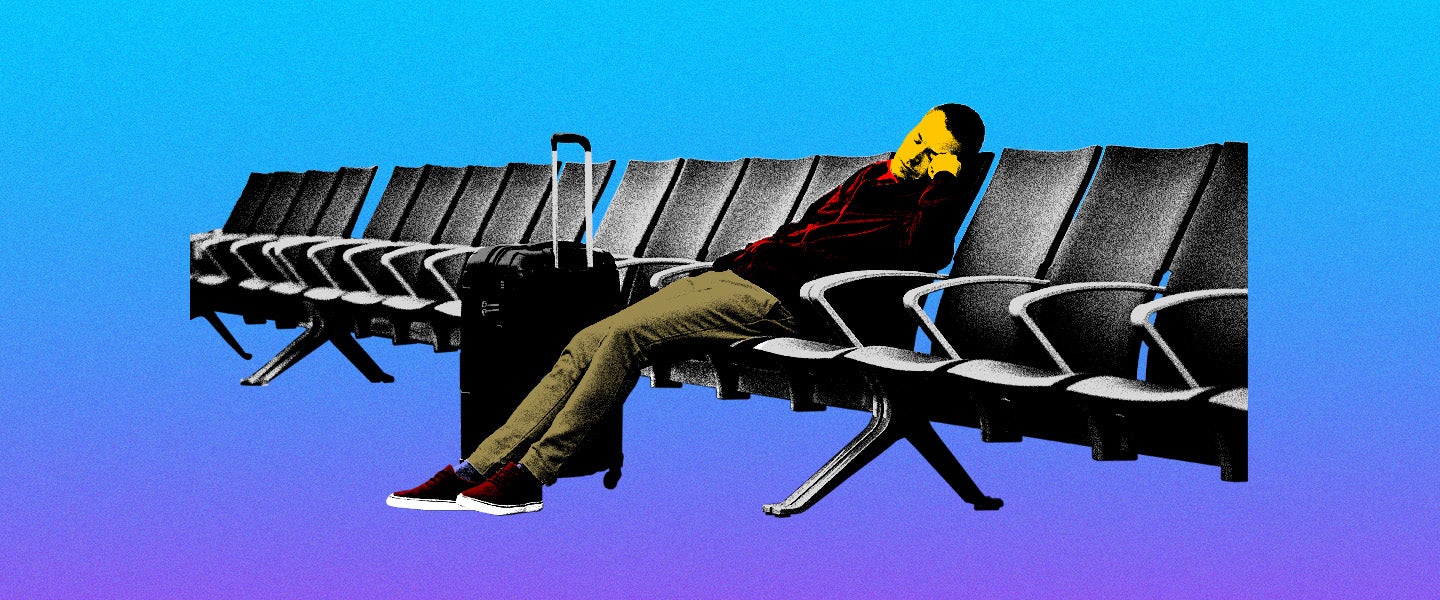So, you missed your flight, and now you have to sleep at the terminal to catch the next one out in the morning. Or maybe your dad and his travel anxiety resulted in your family getting to the airport eight hours early, and you want to take a quick nap to pass some time and ignore his nonstop rambling about excursions and shit. Whatever the cause, you need some sleep, and more importantly, you need to find a good place to make that happen in the confines of a hectic airport.
Fortunately, airports are pretty much safe zones for sleeping, the seats and floors often dotted with semi-dormant travelers. In fact, airports frequently provide refuge from the cold for displaced persons who want nothing more than to snooze for a while without being prodded by policemen. In recent years, though, officials have started kicking out more and more homeless people from airports — a happening that, if anything, points to a need for more shelters, so nobody needs to use the airport to sleep without fear of being covered in snow or shaken awake and told to move along.
Anyhow, if for any reason — waiting on a flight or otherwise — you find yourself seeking sleep in an airport, I caught up with several sleep and travel experts to learn more about how to do so, when employees are shouting over the loudspeaker and the closest object you can find to a bed is a series of pleather seats covered in terrible coffee. Here are their pointers…
Find A Sleep Pod
The absolute best-case scenario, according to Terry Cralle, certified clinical sleep educator and author of Sleeping Your Way to the Top: How to Get the Sleep You Need to Succeed, is that you find yourself in an airport that has some sort of sleeping accommodations. “The Sleepboxes are in full swing in Dulles airport,” she says. “Best thing since sliced bread. They’re amazing and a game-changer for road warriors.” These are essentially miniature soundproof rooms that come equipped with power outlets, and more importantly, memory foam beds where you can snag a nap. You will, however, have to pay hourly — compact Sleepbox rooms cost $25 per hour, and their standard rooms cost $35 per hour. Moreover, as of now, Dulles, in Washington, D.C., is the only airport with Sleepboxes, although a number of airports around the world have other forms of sleeping pods, and more will be coming soon.
Prepare Ahead of Time
The more tired you are, the easier it will be to fall asleep. Bearing that in mind, I asked some advice of Andrew, a captain in the U.S. army who once slept atop a mountain, without a sleeping bag, in under-40-degree weather, and who calls sleeping in a tank “good living” because “some heaters work.” He suggests “staying up late the night before to ride yourself out and not drinking coffee before going to the airport.” Hey, even the floor feels comfortable when you only slept for an hour last night.
Bring a Pillow (Or a Sweater)
“We swear by the Cabeau neck pillows, which can be attached to a personal item, like a small backpack, and can fit under an airplane seat,” says Becca Siegel, of the travel and photo site Half Half Travel. “This neck pillow is unlike other ones we’ve had — we gave all of our other neck pillows away — because it’s firm, so you don’t get the cramps that you get with blow-up-or-bean-bag style neck pillows.” If you travel infrequently and a new neck pillow sounds like a waste of money, Andrew says, “Carry a sweater around the airport — it can always be used as a pillow.” Resourceful!
Get a Good Spot
According to Siegel, the next best spot besides a sleep pod is somewhere in an airline lounge, but of course, you usually need to be a frequent flyer or some kind of esteemed member to gain access to those. So, she also suggests scoping out the seats at your gate, and if they have rails that would make lying flat impossible, “Try heading to another terminal to see if the seats are any different.”
If all of the seats are no good, Andrew says, “Have no shame. Sleep on the ground.” Siegel seconds this notion, adding, “The best spot to lie down on the floor is near waiting areas that don’t have many people — think gates that have a flight departing in two or three hours, not one. Also, sleeping by windows can be quieter, because there are fewer passersby.” Speaking of peace and quiet…
Bring Earplugs or Headphones
Earplugs are a cheap and simple solution for drowning out the gate attendant yelling over the loudspeaking for a “John Smith, get the fuck over here!” But if you need some new headphones and are willing to spend a few hundred dollars on noise-cancelling ones, Siegel says, “We bring the Bose QuietComfort 35 headphones to drown out noise on planes and in airports.”
Finally, just make sure to set an alarm so you don’t end up sleeping past your flight and having to do this all over again.

